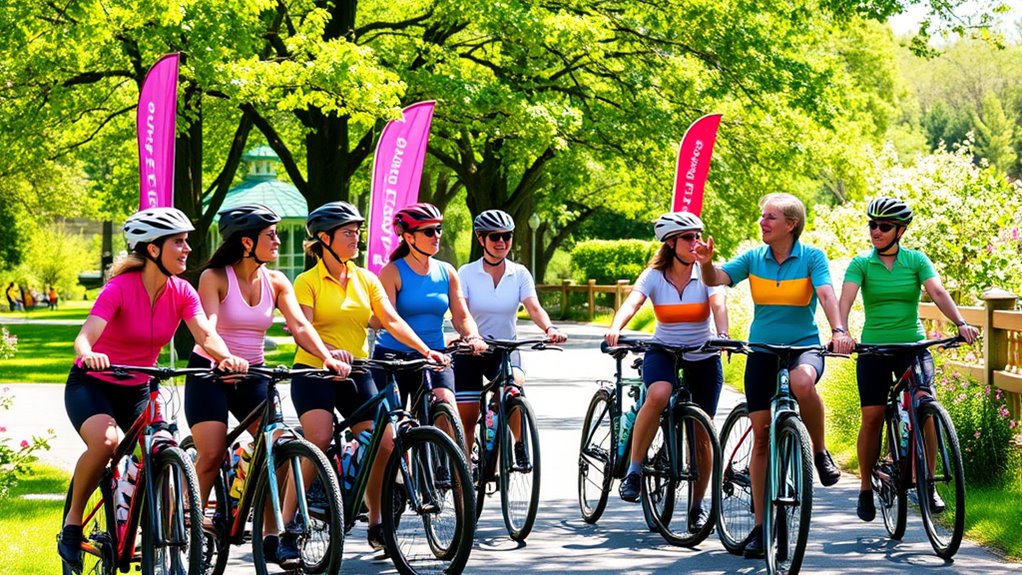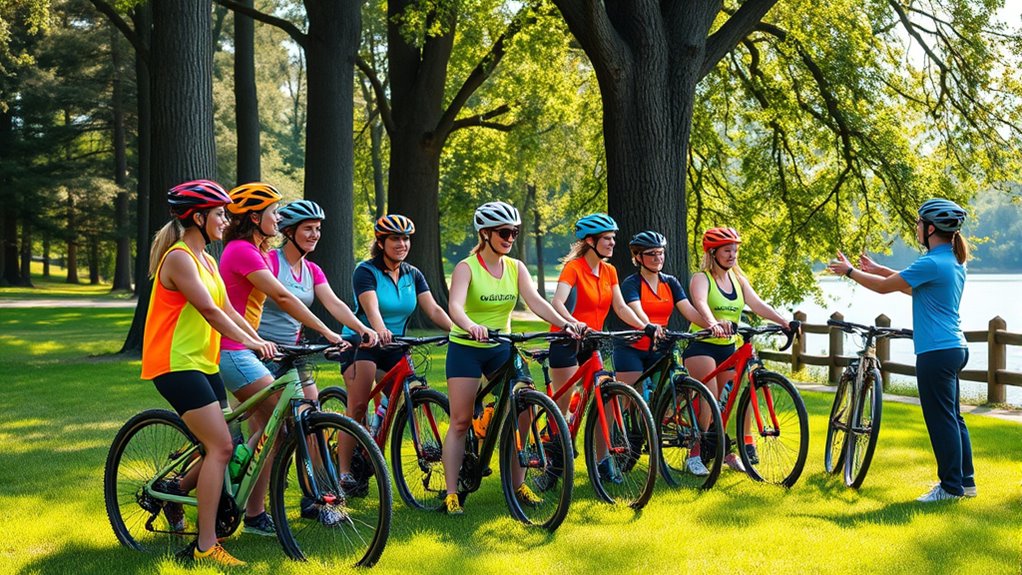To organize a successful women’s bike ride, plan a scenic yet manageable route around 10-15 miles for all skill levels, and set a convenient time, preferably in the morning. Send early invitations with route details and gear suggestions, and guarantee safety by reminding everyone to wear helmets, carry water, and bring repair kits. Support less experienced riders and include a fun post-ride gathering. Keep these tips in mind to ensure a memorable, enjoyable group ride—there’s more to discover as you go!
Key Takeaways
- Choose a scenic, manageable route around 10-15 miles suitable for all skill levels.
- Send early invitations with route details, start time, meeting location, and gear suggestions.
- Emphasize safety: wear helmets, carry water, bring repair kits, and follow group riding guidelines.
- Designate a ride leader and sweep, and provide navigation tools to keep the group coordinated.
- Plan a post-ride social, like gathering at a café or park, to foster camaraderie and relaxation.

Organizing a ladies’ bike ride can be a fun and rewarding experience, but it requires some planning to guarantee everyone has a great time. The first step is choosing a route that’s suitable for all skill levels. Think about the experience of your group members—select a path that’s scenic yet manageable, avoiding overly challenging terrain unless everyone is comfortable with it. Keep the distance manageable; a 10-15 mile ride is usually ideal for mixed skill groups. Map out the route ahead of time and have a clear plan for start and finish points, ensuring there are options for breaks and hydration along the way.
Once you have your route, consider the timing. Pick a day and time that works for most people, preferably avoiding peak traffic hours or extreme weather conditions. Morning rides tend to be cooler and more comfortable, but afternoon rides can work if it’s not too hot. Send out invites well in advance, providing all the details—route map, start time, meeting location, and any gear or supplies they should bring. Encourage participants to RSVP so you can get a head count, which helps with planning support and snacks.
Safety should be a top priority. Remind everyone to wear helmets, carry water, and bring basic repair kits like patch kits or a pump. It’s also a good idea to establish some ground rules beforehand, such as riding at a pace comfortable for everyone, sticking together, and respecting each other’s space. If some riders are new or less experienced, plan to keep the pace slow and steady, and consider pairing them with more experienced cyclists who can offer support and encouragement. Additionally, considering electric bikes can be a great option for those who want a little extra assistance during the ride. Incorporating safety gear such as reflective clothing or lights can further enhance visibility and safety, especially if riding in low-light conditions. Planning for first aid supplies is also wise in case of minor injuries or emergencies. Being aware of brainwave patterns can help you understand how sound and rhythm might influence group cohesion and mood during your ride. Moreover, providing a navigation device or printed route map can help prevent confusion and keep everyone on track, especially in unfamiliar areas. If your group is large, designate a ride leader to keep everyone on track and a sweep rider at the back to ensure no one gets left behind.
To make the ride more enjoyable, think about adding small social touches. Organize a post-ride gathering at a nearby café or park, where everyone can relax, chat, and share experiences. Bringing snacks or drinks for the group can also boost morale during breaks. Remember, the goal is to promote camaraderie and fun, so keep the atmosphere light and encouraging. With thoughtful planning and a friendly attitude, your ladies’ bike ride will be a memorable event that brings everyone closer and gets everyone moving.
Frequently Asked Questions
How Do I Handle Different Skill Levels Within the Group?
When managing different skill levels, you should plan a route that’s suitable for everyone, perhaps with rest stops or shorter options for less experienced riders. Encourage open communication, so beginners feel comfortable asking for help or taking breaks. Pair riders of similar abilities, and set a positive, supportive tone. Remember, your goal is to keep everyone safe, engaged, and enjoying the ride together.
What Safety Gear Is Essential for All Participants?
You should guarantee all participants wear essential safety gear like a well-fitted helmet, which is non-negotiable. Encourage the use of gloves to protect hands, reflective clothing or vests for visibility, and proper footwear for control. Consider adding knee and elbow pads for extra safety, especially for beginners. Remind everyone to carry a small repair kit and water, so they’re prepared and comfortable throughout the ride.
How Can I Encourage Inclusive and Supportive Group Dynamics?
You can foster inclusive and supportive group dynamics by setting a welcoming tone from the start. Encourage open communication, listen actively, and celebrate each rider’s abilities. Make certain everyone feels comfortable sharing their concerns or suggestions. Promote kindness and patience, and avoid competition. By creating a positive environment where all voices are valued, you help build camaraderie and ensure everyone enjoys the ride safely and happily.
What Should I Do in Case of a Bike Breakdown During the Ride?
If your bike breaks down during the ride, stay calm and signal your stop clearly to the group. Use your phone or a repair kit if available to fix the issue. If you’re unable to repair it quickly, inform the group and consider walking your bike to the nearest safe spot or the ride’s endpoint. Remember, safety comes first—don’t hesitate to seek help or call for assistance if needed.
How Do I Choose the Best Route for Diverse Riders?
You’re casting your net wide when choosing a route for diverse riders, making sure it’s accessible and enjoyable for everyone. Think of it as hitting two birds with one stone—consider different skill levels, terrain, and distances. Opt for a route with options for breaks and scenic spots. Gather input from your group beforehand, ensuring everyone feels comfortable and included, so your ride’s a smooth sail for all.
Conclusion
Organizing a ladies’ bike ride can be a rewarding experience that boosts confidence and builds community. Remember, over 60% of women who participate in group rides report feeling more empowered and motivated to stay active. By planning ahead, communicating clearly, and creating a supportive atmosphere, you’ll make sure everyone has a great time. So, get your gear ready, invite your friends, and enjoy the ride — the journey to fun and fitness starts with you!









